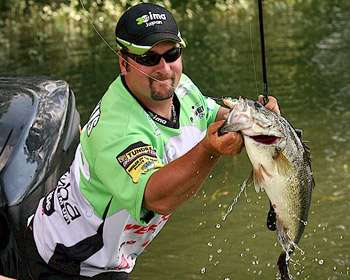
Not many of us weekend anglers pay very much attention to how a bass is hooked. We land it, admire it and let it go.
Elite Series pro Fred Roumbanis points out that taking the time to review how a fish bit and how it's hooked can greatly aid in developing, or further refining, a pattern. "As an example, when you're getting a lot of short strikes or misses, it can be as easy as making a color change," the Oklahoma pro suggests. "Sometimes a color change can make all the difference in the world. It can be as drastic as going from white to black, for instance, or as simple as dying the tail chartreuse."
However, there are times when bass are "hooking up," but still aren't taking the bait aggressively. It's in those situations where Roumbanis believes the solution might involve more than switching to a different colored lure. "If I catch a fish on a jerkbait and notice that the bait is on the outside of the bass' mouth," Roumbanis says.
"I'll simply change out the manufacturer's front hook to a red one. This gives the fish a better target so the lure ends up inside the mouth instead of outside it. "Also, if I'm getting a lot of short strikes or misses, I might go to something completely different, like a drop shot or shaky head jig — something they will take." He continues, "I would love to say that I have some scientific formula on how to determine a fish's mood, but I don't. It's all about trial and error.
If one color isn't working, I'll go to the opposite — or at least try different changes until they start to really take the bait again." Beyond color variations, a hooked (or missed) fish can also tell you much about how fast the lure should be retrieved. "You can get a real good idea of how they're feeding by how they react to your bait," he explains. "A lot of times if the bass are schooling, they may just aggressively slap at a lipless crankbait that is retrieved quickly through the school.
If you can detect what's going on based on those hits, you can vary that retrieval speed until, rather than slapping at it, they'll engulf it." Learning a fish's "mood" by how it bites the bait is critical, but Roumbanis contends that there's just as much (or more) information to be obtained by closely inspecting the bass once it's caught. "When you catch a fish, particularly the first couple of the day, you really want to study it," Roumbanis suggests.
"Look at the color of the bass. If it is pale, it came from deeper water, but if it is dark green, it has been living in shallow water. Anything that you can observe about that bass can quite possibly teach you about the general mood or situation of other bass in the area.
If you'll take the time to study the fish, you'll learn a lot more about a potential pattern than you would if you just caught it and immediately turned it back." Roumbanis points out that if you're catching one bass after another, it's pretty easy to take all the subtleties for granted; however, when the bite is slow, anglers need to focus on the details of each bass. "If I'm out there struggling, that's when I really start to key in on everything each fish was doing, and how it looks once I get it to the boat," he says.
"One of the biggest secrets that I can pass along is to pay close attention to the small, sandpaper like teeth on each bass you catch. If they're sharp, chances are that bass was keying on baitfish. If they're dull, it tells you that they're keying on crawfish, whose hard shells can dull the teeth.
That translates into knowing whether the dominant pattern will be a crankbait, or a jig."
(Provided by Z3 Media)




